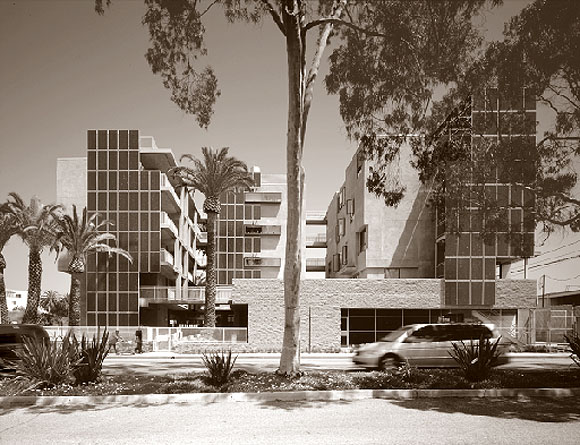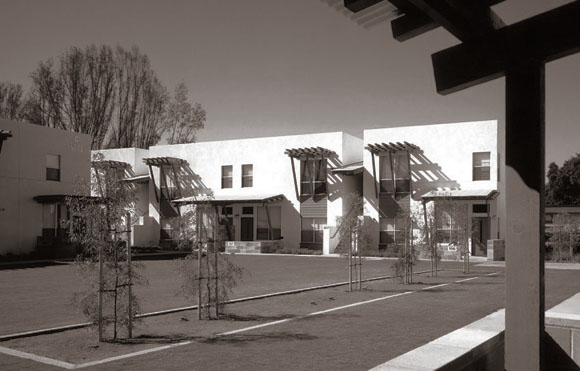Architecture, in contrast to the other professions alongside which the many years of required education cause it to be compared, is positively awash in honors and awards. Design awards illuminate architecture’s distance from law and medicine and its closer relationship to the fine arts. Whether such awards are more valuable financially, in terms of promotion, or as a sociological bulwark doesn’t ultimately matter. Competition is the way of the architect, on many levels, and the recognition garnered from triumph in a well-publicized competition can be the adrenaline in the lifeblood of a firm. There is almost always a direct correlation between the accumulation of this kind of recognition and the potential for more work.
Yet, another stimulant that may contribute more to keeping architects in a profession that is remarkably lacking in financial rewards is the infinitely more personal desire to create architecture that can be defined as “a labor of love.” Such work holds a profound satisfaction that can help bridge the gaps between projects and can sometimes make the difference between “practicing architect” and “former architect.”
Taken from I Thessalonians 2:3, the expression “a labor of love” describes an altruistic impulse, driven by pleasure or interest without expectation of recognition or recompense. For the architect whose commitment to a project transcends both the mundane and occasionally extraordinary impediments that are part and parcel of “labors of love,” acknowledgment by a jury of their peers is often, in the purest sense of the word, a windfall. Marsha Maytum, FAIA, a principal of the award-winning firm Leddy Maytum Stacy and a member of the 2003 AIACC Design Awards jury, recently spoke about this year’s Design Awards and the qualities that distinguish many of the winners as “labors of love.”
Do what is natural to you, and you are sure to get all the recognition you are entitled to. – Rutherford B. Hayes

“I felt that the projects we selected, each in its own way—which was why they were part of the design awards— took the problem at hand and made it something so much more. I look down [the list of winners], and I think that every one of them is addressing interesting and important issues, ones that we as a profession are now facing.” She went on to say, “One of the things that the jury saw—and we had quite a diverse group of jurors—was the passion displayed in the chosen work. What was immediate for everyone about the honor award (First Presbyterian Church of Encino by Abramson Teiger Architects) was the integrity of the design—and the passion with which it was created.” All of the jurors acknowledged a strong emotional response to the redesign of the original, Stygian, mid-century church and admitted to having been moved and absolutely inspired by it. Perseverance, commitment, passion, and integrity were attributes that Maytum and the jury ascribed to most of the winning projects.
The reward for work well done is the opportunity to do more. – Jonas Salk

Maytum made special mention of Colorado Court, by Pugh Scarpa Kodama, and Clifton Hall, by Mark Horton Architects, as accomplishing a great deal within very stringent site and budgetary constraints, as did the Cragmont Elementary School, by ELS Architecture and Urban Design. The Eucalyptus View Cooperative workers’ housing in Escondido, by Studio E Architects, was an immense favorite of hers. “I thought personally that it was a great project because it was very modest, it made very simple moves, yet i t creates such a beautiful statement that it takes such housing to a whole new level. That’s really quite hard to do.”
We give our highest rewards to those who convincingly disprove established beliefs. – Carl Sagan

Environmental sustainability, which is one of the key characteristics of the work of Leddy Maytum Stacy, was another aspect that successful projects shared. Maytum encourages architects to design in a way that not only serves the goals of a particular organization, but also overlays aspects of sustainable design, allowing their clients to be good members of their community. “I would say that it is just one more factor of what goes into designing, and each of the projects that was recognized had a distinct set of circumstances” to resolve in this respect. Maytum acknowledged that one of the ways architects can contribute is by representing the value of the experience that they bring to society on the issue of sustainability. Largely through architects’ efforts and those of environmental activists, “many civic leaders now understand the value and importance of sustainability [and recognize] how interrelated everything is.” These issues will fall to the next generation of designers and architects to continue pursuing.
Art is the imposing of a pattern on experience, and our aesthetic enjoyment is recognition of the pattern. – D. H. Lawrence

While the qualities of passion and perseverance will certainly influence a jury in an entrant’s favor, the basics of good presentation are not to be underestimated, according to Maytum. She lauded the level playing field afforded by the AIACC standards for competition presentation, which acknowledge that smaller firms are generally without the media or graphic design resources of the giants, but cautioned that entrants “not underestimate the importance of good photography. We can only review projects based on what we see, and having good, clear photography helps us to do that.” She stressed, as well, that serious attention should be paid to the written statements that are part of the application. “We sat quietly in a room for two, eight-hour days and read every book or paper for every project,” Maytum said, “so I know that having a clear, concise statement is a tremendous advantage.”
Dignity does not consist in possessing honors but in deserving them. – Aristotle
Maytum also spoke about the design approach that informs her decisions as she sits on various juries, a process she enjoys for the opportunities they afford to interact with other interesting jurors. She said that embracing order and maintaining rigor are important to the design approach at LMS, but that they do not necessitate maintaining a rigid stance. She noted that Bill Leddy often speaks about “poetry and pragmatism” in their design approach. In addition to being made well, “simplicity needs to ring through” in their designs. These things, in turn, have their basis in a sense of order. “Architecture is not one of the easiest careers. I’ve found that people who are practicing architecture do it for their own, very specific reasons—which can take on a whole range of possibilities— but I think that one of the best aspects of projects is that often they turn out to be more gratifying, more satisfying, so that the thinking at the end of the day is, ‘Oh wow. We helped out,’ and we do that by going beyond.”
The architecture firm of Leddy Maytum Stacy in San Francisco—with its precursor firm, Tanner Leddy Maytum Stacy—has been in existence for more than twenty years. In that time it has assumed a leadership role in the areas of sustainability and adaptive reuse. Employing (according to the Northern California Chapter of ADPSR) “rigorous aesthetics, appropriate technology, and environmental sensitivity,” the firm has made an immense impact on the northern California built environment, achieving more than a dozen local, state, and national AIA awards along the way.
Author Lynne D. Reynolds, AIAS, is a student in the architecture program at California College of the Arts (formerly CCAC) who spent most of the previous two decades as a professional photographer of furnishings and interiors.
Originally published 3rd quarter 2003, in arcCA 03.3, “Done Good.”






